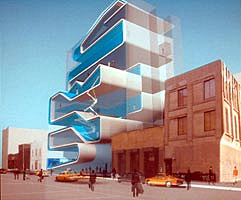 |
The hybrid nature of the Museum of Art and Technology, both museum and production/education facility, provokes an architecture of cross-programming and spatial interweaving. The architectural concept begins with a pliable ribbon that partitions the programming; production spaces to one side (blue) and presentation spaces to the other (gray). The ribbon undulates from side to side as it climbs from the street, floor folding into wall, folding into floor, slipping back gradually to fit the diminishing zoning envelope. With each change of direction the ribbon alternately enfolds a production or presentation space, thus combing together the major program divisions and populations of the building (residents and visitors) as well as their diverse activities and speeds. While residents use the east core and visitors use the west, each must pass through the spaces of the other when circulating between successive levels. The ribbon is sometimes sheared and slipped into alignment with a level above or below, thus, conjoining a production and presentation space. The building is designed as a system of controlled contamination. Between the blue and gray plies is the building’s nervous system, which can be stripped out every several years. The project was selected in a two-part international competition.
DS+R




